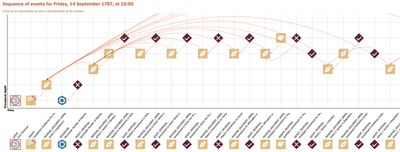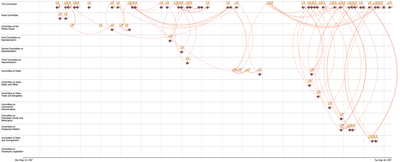He Said, She Said!
Visualising how complex negotiations and social media conversations evolve over time
KCL Informatics has paired up with a team from Oxford University to develop an entirely new way of mapping how conversations in formal settings and on social media unfold over time. Visualising complex timelines, this new technology promises to break through the accountability gridlock that many social media platforms face.
Introduction
As the eldest delegate at the Constitutional Convention of 1787, Benjamin Franklin had no easy task in steering the heated debate about the institutional foundations of the United States. At the end of a gruelling process that would span over four months he was approached by a prominent Philadelphian society lady who asked, ‘Well, Doctor, what have we got – a Republic or a Monarchy?’ To which he retorted, ‘A Republic, if you can keep it’. Franklin’s response is a cautionary tale about the sharp divisions and conflicts in formal negotiations in high-stakes scenarios.
From climate change to trade talks to nuclear disarmament, formal negotiations are part and parcel of international affairs. The treaties and agreements that come out of such talks govern many aspects of our lives. Yet the layers of complexity behind decision-making processes are not always immediately apparent in the final treaty document which is proudly presented at the concluding all-smiles press conference.
A better sense of the dynamics behind the scenes would often help us to understand why big historical events turned out the way they did. In many instances, records of formal negotiations do exist, of course. But they’re often difficult to follow and don’t always provide much detail about the sequences in which decisions were taken, or the hierarchies between decision-makers. Sometimes important details about proposals that would be voted down later in the process are missing.
Using the US Constitution as a case study, Dr Alfie Abdul-Rahman from KCL Informatics and her collaborators from Oxford University have built a model that pierces through the complexities of historical texts. And they’re now building on this approach to visualise the origins and evolution of complex conversations on social media in entirely new ways. Making it easier to disentangle who said what, where and when will make it much more straightforward to hold actors accountable for what they communicate on various platforms.
Background: Quilling the threads of history
Over the past couple of years, Dr Abdul-Rahman and her collaborator Dr Nicholas Cole from the University of Oxford have built and fine-tuned Quill, a publicly available service that helps domain experts to transform records of formal negotiations into a model that visualises decision-making processes. The platform unpacks negotiations such as legislative and parliamentary processes. This makes Quill a valuable resource not just for legal experts but also for researchers and students in history.

In principle, the drilling process cries out for automation: drill down the length of a standard pipe, secure the well, screw another pipe to the top and drill down further. Previous attempts at automation involved writing static scripts that would tell the system what to do. But the engineers quickly realised that it wouldn’t work. ‘The joke at the time was that it took more people on the rig to drill automatically than it took to drill manually, because you had all the drilling crew and then you also had to have the software engineers to repair the software every time it failed’, Prof Long recalls. While the drilling process seems repetitive from a safe distance, in practice it’s always very different.
The platform enables researchers to dig deep and uncover the details of varied processes at the end of which a negotiated text emerges. This 360° view makes for a much more rounded and complete picture of the most significant historical events. Quill makes it possible to follow multiple actors across multiple events to see how they interact – a level of detailed understanding that is not accessible by just sifting through an archive of records.

Quill provides various tools for visualising summary statistics such as the above, timelines of events and network diagrams that capture the interaction of delegates, where they join forces and where they go separate ways. The team has published various academic articles about Quill alongside technical reports that demonstrate the richness of the platform.
The new project at KCL: visualising massive corpuses of social media data
An interactive timeline sits at the heart of many of Quill’s visualisation tools. Most of us will associate timelines with social media platforms such as Twitter and Facebook, but also collaborative document editing on shared Microsoft or Google drives. The growing relevance of timelines for human-computer interaction today got the team to think how they could extend the Quill framework to the study of the kinds of conversations we have on social media today. ‘We wanted to see whether we could actually apply the same technique to social media because on Twitter you also have different conversations going across from different people and different timelines’, Dr Abdul-Rahman explains. ‘Just as in the case with the Constitution, you have different proposers having different issues to speak about, and you can actually consider this a document and track it as it moves across’.
At KCL Informatics, Dr Abdul-Rahman and her collaborators are putting together a novel approach to visual analytics that visualises multiple conversational timelines. While it is fairly straightforward to follow a single actor across one timeline, the task quickly becomes colossal when the number of actors and their interactions rises, which obscures the origins, targets and influencers of conversations. To disentangle this chatty mess, the team is working on new methods for thematic provenance tracing, machine learning, and composite visualisations. ‘So obviously this is a question of big data but how big is the data really? In the digital humanities, data is actually quite huge and rich’, Dr Abdul-Rahman continues. ‘And I think that got me very interested in working interdisciplinarily, especially with humanities scholars.’
For an early career researcher, Dr Abdul-Rahman considers KCL Informatics a particularly good place to carry out this line of work. ‘We’re part of the Human Centred Computing group. We’re probably the smallest group in the department but quite possibly one of the most vibrant ones too,’ Dr Abdul-Rahman laughs. ‘We have an excellent support and feedback system in place, a rich and wide scientific network, and are collaborating a lot. New ideas are bouncing back and forth all the time,’ she continues.
Looking ahead: the next steps
The team has a busy couple of months ahead. Following a composite approach that integrates their expertise in processing records of formal negotiations such as the US Constitutional Convention, the team is building an interactive visual analytics framework for querying large sets of data from conversations. This requires building strategies to visualise timelines in a compact and compressed manner. On top of that, provenance-tracing is introduced to allow users to move back in time to identify when exactly a new idea was injected into the conversation. New bespoke machine learning routines will help classify conversations.
Dr Abdul-Rahman and her team are looking forward to making a web-based interface of the new service available to the public. One of the key motivations for pursuing this line of work is the widely shared discontent with a lack of accountability on social media. In December 2020, the UK Home Secretary Priti Patel announced announced ‘a new age of accountability’ for social media and has promised new laws to make online spaces safer. The visualisation tool which the team at KCL Informatics is putting together is a big step towards this goal. ‘We want to build a software tool that allows people to actually see how conversations unfold and where they started to make actors more accountable’, Dr Abdul-Rahman concludes.
This story was written by Juljan Krause, a professional science writer and final-year PhD Researcher in quantum communication.